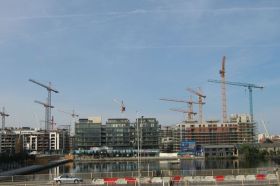Construction, EU – Baltic States, Good for Business, Legislation, Real Estate
International Internet Magazine. Baltic States news & analytics
Thursday, 25.04.2024, 16:09
EU construction standards: effect for business
 Print version
Print version |
|---|
Eurocodes
in construction industry are important for business. They can help to harmonize
the services market in the construction sector; they will encourage and
facilitate the marketing and use of materials, structural components and kits,
to name a few.
The approach of structural
reliability is based on the semi-probabilistic method (limit-state performance
design and partial factors method). The major concepts developed in the
Eurocodes are: - fundamental requirements (safety, serviceability, fire and robustness);
- reliability differentiation; - design working life; - durability, and -
quality assurance.
http://eurocodes.jrc.ec.europa.eu/showpage.php?id=11
*) Regulation (EU) no 305/2011,
the European Parliament & the Council of 9 March 2011
laying down harmonised
conditions for the marketing of construction products and repealing
Council Directive 89/106/EEC.
In: Official Journal of the European Union, 4.4.2011, L 88/5-43.
Major concepts
= Fundamental requirements (safety,
serviceability, fire and robustness).
The structure and structural
members should be designed, executed and maintained in such a way that they
meet the following:
- Serviceability requirement –
the structure during its intended life, with appropriate degrees of reliability
and in an economic way, will remain fit for the use for which it is required.
Safety requirement – the
structure will sustain all actions and influences likely to occur during
execution and use.
- Fire requirement – the
structural resistance shall be adequate for the required period of time.
- Robustness requirement – the
structure will not be damaged by events such as explosion, impact or
consequences of human errors, to an extent disproportionate to the original
cause.
= Reliability differentiation. Different levels of reliability may be adopted for
both, structural resistance and serviceability. The choice of the levels of
reliability for a particular structure should take account of the relevant
factors, including:
- the possible cause and/or
mode of attaining a limit state;
- the possible consequences of
failure in terms of risk to life, injury and potential economical losses;
- public aversion to failure,
and social and environmental conditions in a particular location;
the expense and procedures
necessary to reduce the risk of failure.
The levels of reliability that
apply to a particular structure may be specified in one or both of the
following ways:
- by classifying the structure
as a whole;
- by classifying its
components.
= Design working life. The design working life is the assumed period for which a structure is to
be used for its intended purpose with anticipated maintenance but without major
repair being necessary. The notion of design working life is useful for:
- the selection of design
actions (e.g. wind, earthquake);
- the consideration of
material property deterioration (e.g. fatigue, creep);
- evaluation of the life cycle
cost;
- developing maintenance
strategies.
= Durability. The structure should be designed in such a way that deterioration should
not impair the durability and performance of the structure having due regard to
the anticipated level of maintenance.
= Quality assurance. The EN Eurocodes assume that appropriate measures are taken in order to
provide a structure, which corresponds to the requirements and to the
assumptions made in the design. These measures comprise definition of the
reliability requirements, organisational measures and controls at the stages of
design, execution, use and maintenance.
More about the EN Eurocodes
The EN
Eurocodes are expected to contribute to the establishment and functioning of
the internal market for construction products and engineering services by
eliminating the disparities that hinder their free circulation within the
Community. Further, they are meant to lead to more uniform levels of safety in
construction in Europe.
The EN Eurocodes are the
reference design codes. After publication of the National Standard transposing
the Eurocodes and the National Annexes, all conflicting standards shall be
withdrawn. It is mandatory that the EU member states accept national designs to
the EN Eurocodes.
The"codes" are
currently at the stage of maintenance and evolution in order to address the
variety of new methods, new materials, new regulatory requirements and new
societal needs developing and to extend harmonisation.
The EN Eurocodes apply to
structural design of buildings and other civil engineering works including: -
geotechnical aspects; - structural fire design; - situations including
earthquakes, execution and temporary structures.
For the design of special
construction works (e.g. nuclear installations, dams, etc) other provisions
than those in the EN Eurocodes might be necessary.
The EN Eurocodes
cover:- basis of structural design (EN 1990);- actions on
structures (EN 1991); - the design of concrete (EN 1992), steel (EN 1993),
composite steel and concrete (EN1994), timber (EN 1995), masonry (EN 1996) and
aluminium (EN 1999) structures; - together with geotechnical design (EN 1997);
and the design, assessment and retrofitting of structures for earthquake
resistance (EN 1998).
http://eurocodes.jrc.ec.europa.eu/showpage.php?id=1
Benefits of use
There are numerous benefits
using EN Eurocodes: - they will help to harmonize the services market in the
construction sector; - they will encourage and facilitate the marketing and use
of materials, structural components and kits; - greater transparency in design methods
will ease communication between designers, authorities and clients; - common
design aids (manuals, handbooks, etc.) and software will be prepared and used;
- the competitiveness of the European civil engineering firms, contractors,
designers and product manufacturers in their worldwide activities will be
increased.
Besides, the EN Eurocodes will
lead to a more uniform level of constructions safety in the different European
regions.
By instituting a
common design framework, EN Eurocodes will enhance and be a common basis for
research and development in civil engineering








 «The Baltic Course» Is Sold and Stays in Business!
«The Baltic Course» Is Sold and Stays in Business!

